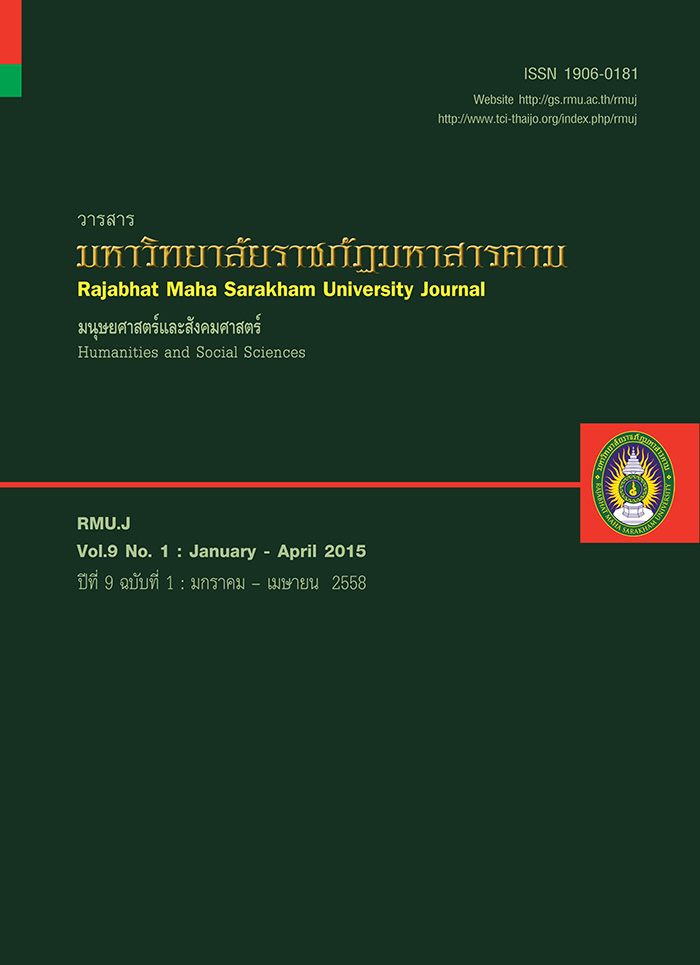การใช้ภาษาและแนวคิดในโฆษณาเชิงบทความผลิตภัณฑ์นมผงสำหรับเด็ก;Language Use and Concept in Advertorial of Powdered Dairy Product for Children
Main Article Content
บทคัดย่อ
งานวิจัยนี้มีวัตถุประสงค์เพื่อศึกษาการใช้ภาษาโน้มน้าวใจและแนวคิดที่ปรากฏในโฆษณาเชิงบทความผลิตภัณฑ์นมผงสำหรับ
เด็ก โดยเสนอผลการวิจัยแบบพรรณนาวิเคราะห์ ผลการศึกษาภาษาในโฆษณาเชิงบทความผลิตภัณฑ์นมผงสำหรับเด็ก ในนิตยสารรัก
ลูก ปี พ.ศ. 2555 พบว่า องค์ประกอบของบทโฆษณามีทั้งหมด 5 ส่วน คือ พาดหัวเรื่อง พาดหัวเรื่องรอง เนื้อหา คำขวัญ และชื่อยี่ห้อ
หรือชื่อสินค้า มีการใช้คำ มีทั้งหมด 10 ลักษณะ ได้แก่ 1) การใช้คำแทนเด็กหรือลูก 2) การใช้คำแทนแม่ 3) การใช้คำซ้อน 4) การใช้
การซํ้าคำ 5) การใช้คำเร้าความสนใจ 6.การใช้คำขยายบอกลักษณะของเด็ก 7) การใช้คำสัมผัสคล้องจอง 8) การใช้รูปคำศัพท์ภาษา
อังกฤษ 9) การใช้คำทับศัพท์ภาษาอังกฤษ และ10) การใช้โวหารภาพพจน์ จาก 10 ลักษณะที่พบนี้ มีการใช้รูปศัพท์ภาษาอังกฤษและ
คำทับศัพท์ภาษาอังกฤษมากที่สุดในส่วนของเนื้อหาบทโฆษณา ส่วนการใช้โวหารภาพพจน์ พบการใช้บุคลาธิษฐาน ในข้อความพาดหัว
เรื่องและข้อความพาดหัวเรื่องรอง และการใช้โวหารอุปลักษณ์ในเนื้อหาบทโฆษณา และการใช้ประโยค พบการใช้ประโยคแจ้งให้ทราบ
ประโยคบอกให้ทำ และประโยคถามให้ตอบ โดยพบประโยคแจ้งให้ทราบที่มีเจตนาบอกเล่ามากที่สุด
การใช้ภาษาเพื่อโน้มน้าวใจในโฆษณาเชิงบทความผลิตภัณฑ์นมผงสำหรับเด็ก ในนิตยสารรักลูก ปี พ.ศ. 2555 พบการใช้ภาษา
เพื่อโน้มน้าวใจ 4 ลักษณะ ได้แก่ การโน้มน้าวใจด้านเหตุผล การโน้มน้าวใจด้านอารมณ์ การโน้มน้าวใจด้านเหตุผลและอารมณ์ร่วมกัน
และการโน้มน้าวใจด้านศีลธรรมจรรยา ซึ่งพบว่ามีการใช้ภาษาเพื่อโน้มน้าวใจด้านอารมณ์มากที่สุด
การใช้ข้อความแฝงแนวคิดที่ผู้ผลิตผลิตภัณฑ์นมผงสำหรับเด็กต้องการสื่อถึงผู้บริโภค พบ 5 แนวคิด คือ แนวคิดด้านร่างกาย
และพัฒนาการ แนวคิดด้านอารมณ์และสังคม แนวคิดด้านสติปัญญา แนวคิดด้านการเลี้ยงดู และแนวคิดด้านคุณสมบัติของนมซึ่งแนวคิดที่พบมากที่สุดคือแนวคิดด้านการเลี้ยงดู
The objectives of this research were to study the persuasive language use and the concepts conveyed
in the advertorial of powdered dairy products. The data of advertisements was collected from Ruk Luke
magazine published in 2012. Descriptive analysis was approached for this study. The results of the study
found that there were 5 components in the advertorial: headline, sub-headline, content, slogan and brand
name. There were 10 word usages consisted of: 1) word usages as a substitution for children, 2) word usage
as a substitution for mother, 3) synonymous compound words, 4) reduplication usage, 5) word usage for
encouraging attention, 6) modifier usage, 7) word rhythm in use, 8) English vocabulary usage, 9) English
transliteration usage and 10) figurative language usage. The findings revealed that English words and English
transliteration were used most in the part of content in the advertorials. Moreover, those advertorials were
containing figurative languages. Personification was mostly found in the headlines and sub-headlines while
metaphor was found in the advertorials' content and words in the sentence. The result also showed that
informative, imperative and interrogative sentences were found in the advertorials. The informative sentences
were found most in the aspect of affirmative sentences.
There were four aspects of persuasive languages being conveyed by the advertorials: reasonable,
emotional, reasonable and emotional, and moral persuasions. The most persuasive language was emotional
aspect. In addition, there were 5 concepts containing in the messages in order to communicate to the
consumers: physical development, emotion and social, intellection, nurture and qualified milk. The concept
of child nourishing was at a high level.
Article Details
1. บทความที่ลงตีพิมพ์ทุกเรื่องได้รับการตรวจทางวิชาการโดยผู้ประเมินอิสระ ผู้ทรงคุณวุฒิ (Peer Review) สาขาที่เกี่ยวข้อง อย่างน้อย 3 ท่าน ในรูปแบบ Double blind review
2. ข้อคิดเห็นใด ๆ ของบทความที่ลงตีพิมพ์ในวารสารมหาวิทยาลัยราชภัฏมหาสารคาม นี้เป็นของผู้เขียน คณะผู้จัดทำวารสารไม่จำเป็นต้องเห็นด้วย
3. กองบรรณาธิการวารสารมหาวิทยาลัยราชภัฏมหาสารคาม ไม่สงวนสิทธิ์การคัดลอกแต่ให้อ้างอิงแสดงที่มา


